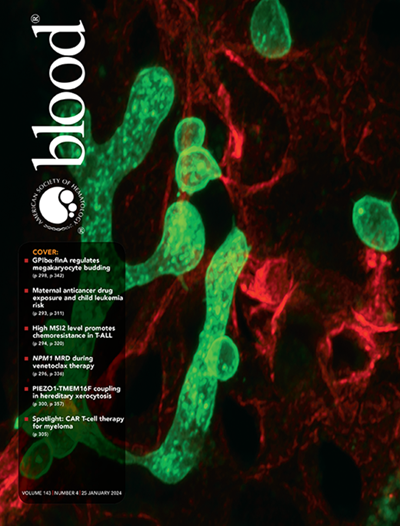CUX1 restrains latent hematopoietic stem cell plasticity by suppressing stem cell-intrinsic inflammatory pathways.
IF 23.1
1区 医学
Q1 HEMATOLOGY
引用次数: 0
Abstract
Long-term maintenance of somatic stem cells relies on precise regulation of self-renewal and differentiation. Understanding the molecular framework for these homeostatic processes is essential for improved cellular therapies and treatment of myeloid neoplasms. CUX1 is a widely expressed, dosage-sensitive transcription factor crucial in development and frequently deleted in myeloid neoplasia in the context of -7/(del7q). Here, using novel mouse models and single-cell approaches, we report that dynamic and distinct CUX1 levels are integral to hematopoietic stem cell (HSC) activity. Knockdown of CUX1 reverses HSC differentiation and strikingly re-endows progenitors with stem cell function, accompanied by restoration of the HSC transcriptome and DNA accessibility landscape. CUX1 mediates these activities, in part, via suppressing endogenous retroelements (EREs) and the ensuing interferon-stimulated gene expression program. Both EREs and the interferon response are upregulated in CUX1-deficient acute myeloid leukemia (AML), suggesting a conserved role of CUX1 in regulating these elements. These data establish an unexpected entwinement of stem cell-intrinsic innate immune activation and the transcriptional programs of stem cell identity. Further, we reveal the profound effects of transcription factor levels in cell fate.CUX1通过抑制干细胞内在炎症通路抑制造血干细胞的潜在可塑性。
体细胞干细胞的长期维持依赖于自我更新和分化的精确调节。了解这些稳态过程的分子框架对于改善细胞治疗和髓系肿瘤的治疗至关重要。CUX1是一种广泛表达的、剂量敏感的转录因子,在发育中至关重要,在-7/(del7q)的背景下,在髓系肿瘤中经常被删除。在这里,我们使用新的小鼠模型和单细胞方法,报告了动态和不同的CUX1水平对造血干细胞(HSC)活性是不可或缺的。CUX1的敲低逆转了HSC分化,并显著地重新赋予祖细胞干细胞功能,同时恢复了HSC转录组和DNA可及性景观。CUX1部分通过抑制内源性逆转录因子(EREs)和随后的干扰素刺激基因表达程序来介导这些活性。在CUX1缺乏的急性髓性白血病(AML)中,EREs和干扰素反应均上调,表明CUX1在调节这些元素中起保守作用。这些数据建立了干细胞内在先天免疫激活和干细胞身份转录程序的意想不到的纠缠。此外,我们揭示了转录因子水平对细胞命运的深远影响。
本文章由计算机程序翻译,如有差异,请以英文原文为准。
求助全文
约1分钟内获得全文
求助全文
来源期刊

Blood
医学-血液学
CiteScore
23.60
自引率
3.90%
发文量
955
审稿时长
1 months
期刊介绍:
Blood, the official journal of the American Society of Hematology, published online and in print, provides an international forum for the publication of original articles describing basic laboratory, translational, and clinical investigations in hematology. Primary research articles will be published under the following scientific categories: Clinical Trials and Observations; Gene Therapy; Hematopoiesis and Stem Cells; Immunobiology and Immunotherapy scope; Myeloid Neoplasia; Lymphoid Neoplasia; Phagocytes, Granulocytes and Myelopoiesis; Platelets and Thrombopoiesis; Red Cells, Iron and Erythropoiesis; Thrombosis and Hemostasis; Transfusion Medicine; Transplantation; and Vascular Biology. Papers can be listed under more than one category as appropriate.
 求助内容:
求助内容: 应助结果提醒方式:
应助结果提醒方式:


